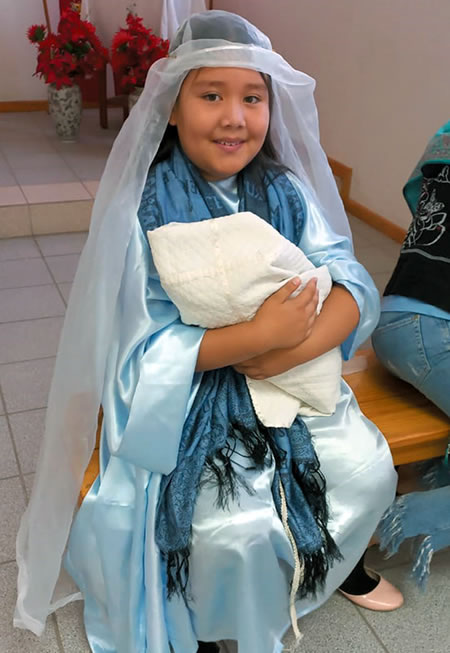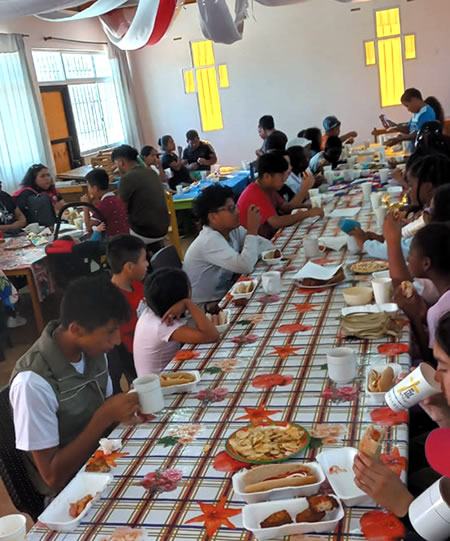
In December 2022, I was getting ready to celebrate Christmas for the third time since I came north to work in Alto Hospicio, a municipality located near the city of Iquique, Chile, in the Atacama desert. I thought that it would be similar to what I had experienced in the past two years marked by the pandemic. However, a couple of weeks before Christmas, I discovered something new about the celebration of Christmas in the north of Chile. Every morning, caravans of trucks and cars appeared on the streets. The trucks had lots of Christmas lights and decorations with Christmas music playing loudly. Standing on a platform of the truck, there was always a man dressed as Santa Claus (El Viejito Pascuero) and accompanied by his elves. As the trucks and cars drove by, the occupants threw out

handfuls of candies to the children waiting on the sidewalks. The caravans started circulating through the streets early in the morning and usually finished at dark. I discovered that in the 1950s this tradition began and the caravans were known as carros alegóricos (allegory caravans). My understanding of allegories is that they are stories or poems which are meant to reveal hidden meanings. I suppose that these carros alegóricos are meant to help the children to celebrate Christmas with joy. My problem is that they have nothing to do with the birth of Christ. After a few days of listening and watching the caravans, another image surfaced in my mind, that of Mary and Joseph not finding a room in the Inn of Bethlehem. I realized that it was the responsibility of our parish to make room for the Christ child in the minds and hearts of children.
The lay pastoral agents, Sisters and priests of the parish of Sagrado Corazón de Jesús organized a series of activities to help families celebrate Christmas in a way which is more faithful to the history of the birth of Christ. Our parish has fourteen tomas (squatter settlements). A small group of mothers from the toma Santa María helped the children to build their own Christmas pesebre (crib) with figures made of cardboard and cloth cuttings. Jorge Mendoza, an experienced carpenter and parish catechist, worked with the children to build the stable. Monica Escalante, Jorge’s wife, with the mothers of the children, organized a Christmas fiesta for the children and their parents. When the families were seated, the Christmas crib was blessed. The following Sunday it was placed at the side of the main altar of the chapel. There were small gifts for every child and plenty to eat with 160 hotdogs and hundreds of bowls of ice creams consumed! Benefactors from the city of Iquique provided the gifts, and the parish provided the food.
Our child actors were able to identify with the stories of the Nativity and the Epiphany, because they too had been forced to leave their homes and travel long distances to come to a country where there was no room in the inn for them.
Two other Christmas fiestas were also organized. In the chapel of Nuestra Señora del Carmen (Our Lady of Mount Carmel), the Corde Jesus sisters and the pastoral council organized a fiesta for the children and their parents. The families were encouraged to bring their images of the Christ child to be blessed. On Christmas Eve, forty families received a Christmas supper prepared by the Sisters and couples of the chapel.

At the southern end of the parish there is a new toma known as El Paso de la Mula (the mule’s path). Squatter settlements in other parts of Chile are known as callampas (mushrooms) because of the speed at which they grow like mushrooms in the ground. El Paso de la mula sprung up and grew rapidly within a year and continues to grow. Immigrant families from Bolivia and Venezuela set up makeshift dwellings. They hope that the municipality of Alto Hospicio will install electricity. Water is delivered regularly by trucks from the municipality.
The Daughters of Charity, together with the parish, have reached out to help the Bolivian and Venezuelan families that have settled there. A few weeks before Christmas, our new bishop, Monseñor Isauro Covili, OFM (the Franciscans), blessed the new community center of Sagrada Familia (Holy Family) built with the contributions from the parish, the Daughters of Charity and Columban benefactors.
For the Christmas fiesta, the children dressed as angels, shepherds, Mary and Joseph and put on a short play of the Nativity. That was followed by a gathering with plenty to eat and gifts for the children. The social apostolate of the parish prepared more than 200 Christmas dinners which were distributed to families in need and to the homeless on Christmas Eve.
The Christmas celebrations did not end the day after Christmas. The children and mothers from the toma Santa María started preparing their own Epiphany celebration. The day before the feast of the Epiphany they gathered in the chapel of Sagrado Corazón de Jesús. As the story of the appearance of the Magi was read from the Gospel of St. Matthew, the children dressed in costumes and reenacted the encounter of the three Wise Men with the Virgin Mary. What impressed me most was the enthusiasm and joy of the children as they acted out the Epiphany. After a big round of applause, there were hymns and prayers to honor Emmanuel (God with us).
Our child actors were able to identify with the stories of the Nativity and the Epiphany, because they too had been forced to leave their homes and travel long distances to come to a country where there was no room in the inn for them. They brought the gifts of their childlike faith to our parish communities where there will always be a welcome for them.
Columban Fr. Michael Hoban lives and works in Chile.